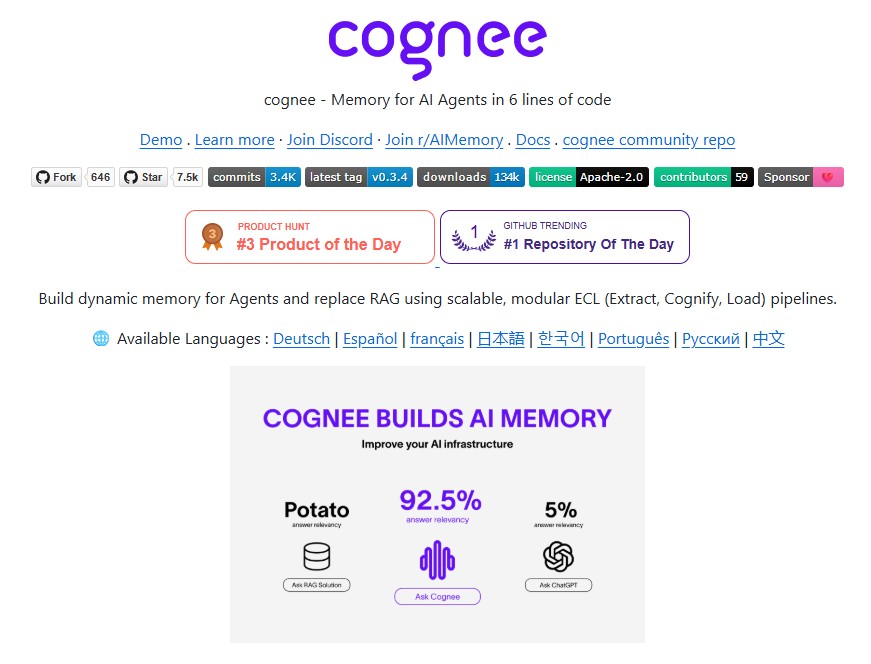Artificial Intelligence is evolving rapidly, but one of the biggest challenges for developers is building agents that remember, reason and adapt. Traditional RAG (Retrieval-Augmented Generation) systems often fall short when handling context, scalability and precision. That’s where Cognee comes in.
It is an open-source framework designed to provide AI agents with memory using a unique ECL (Extract, Cognify, Load) pipeline. With just a few lines of code, developers can transform conversations, files and multimedia into a knowledge graph and vector-based memory layer.

In this blog, we’ll explore what it is and why it matters, its key features, how to get started, the benefits of self-hosted versus hosted deployment and some real-world applications that showcase its power.
Why Cognee?
Most RAG systems work by fetching relevant chunks from a knowledge base when prompted. While effective for simple lookups, they often lack dynamic memory and contextual reasoning. It replaces this static approach with a graph and vector-powered memory system that is:
- Scalable – handles millions of data points efficiently
- Modular – customizable pipelines for different use cases
- Precise – increases the accuracy of AI responses
- Cost-effective – reduces compute and developer effort
By combining knowledge graphs and vector embeddings, it enables agents to “think” with memory instead of just retrieving snippets.
Key Features
Whether you’re a researcher, developer, or enterprise team, it offers a wide range of features:
- AI Memory Layer – store and interconnect documents, conversations, images and audio.
- Graph & Vector Hybrid – unify structured knowledge graphs with unstructured vector search.
- 30+ Data Source Integrations – ingest data seamlessly from different platforms.
- Pythonic Pipelines – simple, readable pipelines for data processing and search.
- Customizable Architecture – extend with your own tasks, APIs and workflows.
- Self-hosted & Hosted Options – choose between open-source control or managed UI.
This makes it a drop-in replacement for RAG systems while providing long-term memory for agents.
Getting Started
It supports Python 3.10 – 3.12 and can be installed easily:
uv pip install cognee
Or using pip / poetry.
Basic Example in Python
import cognee
import asyncio
async def main():
await cognee.add("Cognee turns documents into AI memory.")
await cognee.cognify()
await cognee.memify()
results = await cognee.search("What does cognee do?")
for result in results:
print(result)
if __name__ == '__main__':
asyncio.run(main())
Output:
Cognee turns documents into AI memory.
CLI Usage
cognee-cli add "Cognee turns documents into AI memory."
cognee-cli cognify
cognee-cli search "What does cognee do?"
Or launch the UI with:
cognee-cli -ui
Deployment Options
It offers flexibility depending on your needs:
- Self-hosted (Open Source)
- Full control over data
- Run locally or on your servers
- Ideal for privacy-focused projects
- Hosted Platform (Cogwit)
- Managed UI and enterprise-ready features
- Automatic updates, analytics, and security
- Easy setup with API key integration
This dual approach makes it suitable for both individual developers and large enterprises.
Real-World Applications
It’s memory-first approach opens doors for a wide range of use cases:
- Conversational AI Agents – build chatbots that remember past interactions.
- Research Assistants – organize and query academic papers, datasets and notes.
- Enterprise Knowledge Bases – connect internal documents, manuals and logs.
- Personal Productivity Tools – manage emails, notes and tasks with AI memory.
- GraphRAG Systems – enhance reasoning by combining vector retrieval with graph reasoning.
Community and Contributions
It is backed by a growing open-source community with 7.5k+ GitHub stars, 670+ forks and 70+ contributors.
Conclusion
It is redefining how AI agents handle memory, reasoning and context. By replacing traditional RAG systems with a graph-vector hybrid memory layer, it allows developers to build smarter, more reliable and cost-efficient AI systems.
Whether you’re experimenting locally or deploying enterprise-grade solutions, it offers the flexibility, scalability and intelligence needed to power the next generation of AI agents.
Follow us for cutting-edge updates in AI & explore the world of LLMs, deep learning, NLP and AI agents with us.
Related Reads
- Join the 5-Day AI Agents Intensive Course with Google
- Docling: Simplifying Document Parsing and AI-Ready Data Processing
- Powerful Microsoft Agent Framework: Build, Orchestrate and Deploy AI Agents with Python and .NET
- Reorder Routes to Make All Paths Lead to the City Zero – LeetCode75 Python Solution Explained
- Evaluate Division – LeetCode75 Python Solution Explained

5 thoughts on “Cognee: Powerful Memory for AI Agents in Just 6 Lines of Code”